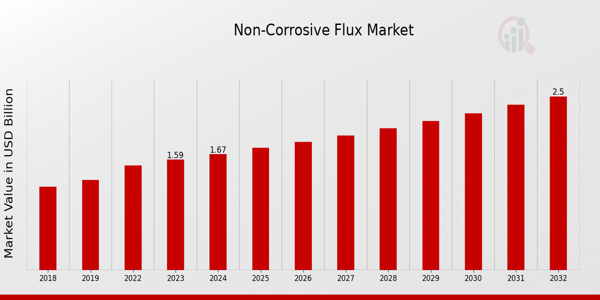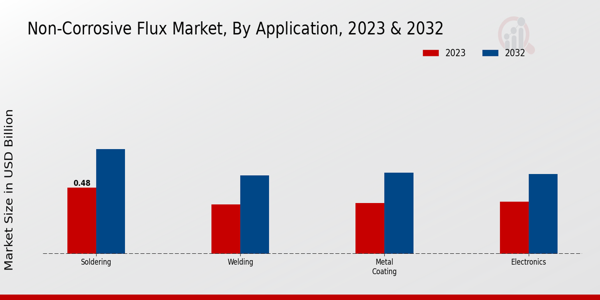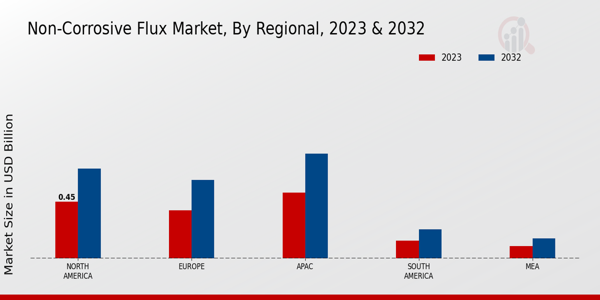Non-Corrosive Flux Market Overview
As per MRFR analysis, the Non-Corrosive Flux Market Size was estimated at 1.76(USD billion) in 2024. The Non-Corrosive Flux Market is expected to grow from 1.85(USD billion) in 2025 to 2.9(USD billion) by 2034. The Non-Corrosive Flux Market CAGR (growth rate) is expected to be around 5.20% during the forecast period (2025 - 2034).
Key Non-Corrosive Flux Market Trends Highlighted
The Non-Corrosive Flux Market is experiencing a notable shift driven by increasing demand for eco-friendly and efficient materials in various industries. The growth in manufacturing sectors, particularly electronics and automotive, is pushing for non-corrosive flux solutions that ensure longer-lasting performance and improved outcomes in soldering processes.
Health and environmental regulations are also significantly influencing market dynamics, as companies prioritize materials that minimize harmful effects on both workers and ecosystems. Furthermore, advancements in formulation technology are enabling manufacturers to create more effective flux products that meet the growing performance expectations of end-users.
Opportunities within the Non-Corrosive Flux Market are expanding as industries seek alternatives to traditional fluxes. The rise of electric vehicles and renewable energy systems is creating an increasing need for non-corrosive materials that contribute to the durability and reliability of components.
Additionally, the growing trend towards automation in manufacturing processes presents chances for innovation in flux formulations, leading to enhanced efficiency and reduced operational costs. As digital and smart technologies come into play, integrating non-corrosive flux into automated processes can streamline production and improve overall output quality.
Recent trends indicate a significant shift towards sustainable practices and reduced environmental impact, influencing customer preferences for non-corrosive flux solutions. Manufacturers are adopting greener practices, aligning their production methods with sustainability goals.
Moreover, the industry is witnessing a surge in partnerships and collaborations aimed at the research and development of advanced fluxes that cater to specific applications while ensuring compliance with stringent environmental standards.
This evolving landscape illustrates the commitment to innovation and adaptability in the non-corrosive flux market, driving its growth and transformation in the coming years.

Source: Primary Research, Secondary Research, MRFR Database and Analyst Review
Non-Corrosive Flux Market Drivers
Increasing Demand for Environmentally Friendly Solutions
As industries across the globe continue to prioritize sustainable practices and environmentally friendly products, the Non-Corrosive Flux Market is witnessing a significant shift towards non-corrosive flux solutions.
Manufacturers and service providers are increasingly aware of the environmental impact of their products, leading to heightened demand for flux that does not emit harmful substances during application or disposal. The move towards greener technology is no longer just a trend but a necessity, prompting companies to invest in research and development for effective non-corrosive flux formulations.
This growing awareness among consumers regarding health hazards associated with traditional soldering and cleaning agents is also a key factor contributing to the market's growth trajectory. Additionally, governments around the world are implementing stringent regulations against environmentally harmful products, compelling industries to transition to non-corrosive alternatives.
As more companies commit to reducing their carbon footprint, the market for non-corrosive flux is poised for robust growth, aligning with global sustainability goals. This shift not only enhances brand reputation but also opens up new avenues for innovation, making it an essential driver for the future of the Non-Corrosive Flux Market.
Technological Advancements in Manufacturing Processes
Continual advancements in technology play a pivotal role in enhancing the efficiency and effectiveness of non-corrosive flux products. In the Non-Corrosive Flux Market, innovations in manufacturing processes allow for the creation of more effective flux formulations that improve performance while minimizing environmental impact.
Recent developments in material science and production techniques have enabled manufacturers to design superior non-corrosive flux that exhibits enhanced thermal properties, better adhesion, and improved compatibility with various substrates.
These technological breakthroughs not only streamline production but also result in higher quality products, attracting more consumers and further propelling market expansion. As industries embrace automated and digitized practices, the demand for reliable and efficient flux products is expected to rise steadily, highlighting the significance of technology as a key driver in this market.
Growth in the Electronics Sector
The rapid expansion of the electronics sector is a vital driver of demand for non-corrosive flux, particularly in soldering applications. As electronic devices become more advanced and ubiquitous, the need for effective soldering materials to ensure durability and performance has escalated.
The Non-Corrosive Flux Market is witnessing increased utilization of non-corrosive flux solutions that not only enhance the reliability of electronic products but also meet the evolving standards set by consumers and regulatory bodies.
With the proliferation of electric vehicles, consumer electronics, and advanced communication technologies, the sector's growth contributes directly to the rising demand for non-corrosive flux solutions designed for effective assembly processes.
Non-Corrosive Flux Market Segment Insights
Non-Corrosive Flux Market Application Insights
The market is segmented into various applications, which include soldering, welding, metal coating, and electronics. Each of these applications held significant importance in terms of market contribution and growth prospects.
Notably, the soldering application led the market with a valuation of 0.48 USD billion in 2023, projected to grow to 0.76 USD billion by 2032. This dominance was attributed to the increasing demand for electronics, where soldering is essential for ensuring reliable electrical connections.
Welding was another substantial segment, valued at 0.36 USD billion in 2023 and targeting 0.57 USD billion by 2032; its growth is driven by the expanding construction and automotive sectors that require robust joints.
Metal coating followed closely, with a valuation of 0.37 USD billion expected to rise to 0.59 USD billion, as industries look for corrosion prevention solutions to enhance the longevity of metal products.
Finally, the electronics segment, valued at 0.38 USD billion in 2023 and expected to grow to 0.58 USD billion by 2032, highlighted the increasing reliance on electronic devices and the critical role non-corrosive flux plays in manufacturing components.
The overall dynamics of the Non-Corrosive Flux Market revenue are influenced by several factors, including advancements in manufacturing technologies, rising concerns regarding environmental impact and safety, and the trend towards automation in various application areas.
While the market presents significant growth opportunities, challenges such as regulatory compliance and competition from alternative products could impact the pace of growth.
Nevertheless, the positive outlook for these applications underlines the increasing significance of non-corrosive flux in both traditional and emerging sectors, thereby contributing to the overall development of the Non-Corrosive Flux Market.
The upcoming years are anticipated to witness increased market growth driven by technological innovations and a growing focus on sustainable practices within manufacturing processes, thus enhancing the market dynamics and competition among the key players involved.

Source: Primary Research, Secondary Research, MRFR Database and Analyst Review
Non-Corrosive Flux Market Form Insights
The Non-Corrosive Flux Market showcases a diverse structure within the Form segment, which includes Liquid, Paste, and Powder forms. This market is witnessing steady growth driven by the increasing demand for non-corrosive flux products in various applications, particularly in electronics and metal joining, where the quality of connections is crucial.
Liquid flux represents a significant portion of the market, favored for its ease of application and effectiveness in soldering processes, while Paste flux is often chosen for its convenience in handling and application precision, especially in circuit board assembly.
Powder flux, while retaining a smaller market share, is notable for its utility in specific industrial applications, where it offers stability and long shelf life. These forms collectively contribute to the Non-Corrosive Flux Market revenue and segmentation, reflecting evolving industry trends focused on sustainability and performance enhancement.
In terms of market growth, factors such as advancements in technology, regulatory changes favoring non-corrosive materials, and the increasing focus on quality control present significant opportunities for manufacturers and stakeholders in the Non-Corrosive Flux Market.
Non-Corrosive Flux Market End Use Industry Insights
A significant part of this market is derived from the automotive sector, where non-corrosive fluxes enhance the reliability and longevity of electrical connections in vehicles. In the electronics industry, these fluxes play a crucial role in soldering processes by preventing corrosion, leading to improved performance and durability of electronic devices.
The aerospace sector also leverages non-corrosive flux materials due to their ability to withstand extreme conditions while maintaining joint integrity, ensuring safety and functionality. Manufacturing processes integrate non-corrosive fluxes to streamline assembly and increase efficiency, appealing to a broad range of industries.
The Non-Corrosive Flux Market segmentation reflects the importance of each of these industries, highlighting key trends that drive demand, such as technological advancements and the pursuit of environmentally friendly solutions.
Overall, the growth in these sectors strengthens the Non-Corrosive Flux Market statistics, presenting numerous opportunities for market expansion and enhancement of product offerings.
Non-Corrosive Flux Market Chemical Composition Insights
The Non-Corrosive Flux Market, particularly within the Chemical Composition segment, is witnessing notable developments as it evolves. This segment consists of various formulations, including Organic, Inorganic, and Mixed compositions.
Organic fluxes are particularly important due to their environment-friendly properties, catering to increased demand for sustainable solutions in various industries. Inorganic fluxes, on the other hand, are valued for their robustness and efficiency in high-temperature applications, making them a popular choice among manufacturers.
Mixed compositions combine the benefits of both to address specific industry requirements, thus holding a significant share of the market. The Non-Corrosive Flux Market statistics reveal that as the industry emphasizes efficiency and eco-friendliness, effective utilization of these different chemical compositions drives market growth.
Furthermore, evolving technological advancements and increased application across sectors such as electronics, automotive, and construction are enhancing the appeal of the Chemical Composition segment. Despite the opportunities, challenges such as stringent regulatory norms and fluctuating raw material prices may impede market growth.
However, the Non-Corrosive Flux Market data highlights that the increasing trend toward innovative flux solutions will continue to pave the way for growth in this sector.
Non-Corrosive Flux Market Regional Insights
Among the regions, North America was the leading market, holding a valuation of 0.45 USD billion, projected to increase to 0.71 USD billion by 2032, indicating its majority holding in the overall market. Europe followed with a revenue of 0.38 USD billion in 2023, expected to rise to 0.62 USD billion, reflecting its substantial contribution to the industry.
The APAC region also demonstrated notable market activity, valued at 0.52 USD billion in 2023 and anticipated to expand to 0.83 USD billion, driven by increasing industrialization and demand for non-corrosive products.
South America, valued at 0.14 USD billion, is expected to grow steadily to 0.23 USD billion, while the MEA region, at 0.10 USD billion, showed potential to reach 0.16 USD billion by 2032. The diverse growth across these regions was spurred by trends towards sustainable manufacturing processes and the necessity for efficient and reliable flux solutions, which create opportunities in both established and emerging markets.
The Non-Corrosive Flux Market segmentation highlights the nuances in regional dynamics that are crucial for industry stakeholders aiming to capitalize on growth potential.

Source: Primary Research, Secondary Research, MRFR Database and Analyst Review
Non-Corrosive Flux Market Key Players and Competitive Insights:
The Non-Corrosive Flux Market has become increasingly competitive as various players strive to meet the growing demand for high-performance soldering materials that ensure reliability and efficiency in electronic applications.
In this market, businesses are not only focused on product quality but also on sustainability and regulatory compliance, which are essential for attracting environmentally conscious consumers and businesses. As technology evolves, manufacturers are actively investing in research and development to create innovative formulations and improve the performance characteristics of non-corrosive fluxes.
This development has been further driven by the rapid advancements in electronics, telecommunications, and automotive sectors, necessitating the use of effective flux solutions that minimize residue, enhance soldering speed, and improve overall assembly reliability.
Universal Solder has established a noteworthy presence within the Non-Corrosive Flux Market, resonating well with manufacturers who prioritize effective soldering solutions. The company's strengths lie in its extensive product range that caters specifically to the varying needs of different applications, including wave soldering and reflow soldering.
Their non-corrosive flux formulations are engineered to create optimal wetting properties while minimizing post-soldering cleaning requirements. Through consistent quality control and a commitment to innovations in product development, Universal Solder not only strengthens its market footprint but also fosters customer loyalty.
With strategic partnerships and collaborations in place, Universal Solder has positioned itself to leverage market trends and ensure that it remains a significant player amidst the competitive landscape. SRA Solder has made its mark in the Non-Corrosive Flux Market by focusing on delivering high-quality products tailored for both hobbyists and industrial applications.
Known for its user-friendly soldering materials, SRA Solder has garnered a strong reputation among electronic hobbyists for consistency and reliability. The company emphasizes the ease of use and performance of its non-corrosive flux products, which is a critical factor for many users aiming for quality solder joints without the hassle of extensive cleaning processes.
SRA Solder's strong distribution network, combined with its dedication to customer support and education, empowers users to achieve better results in their soldering projects. The continuous enhancement of its product portfolio and active engagement with the end-user community positions SRA Solder favorably in a competitive environment that favors innovation and customer-centric solutions.
Key Companies in the Non-Corrosive Flux Market Include
- Universal Solder
- SRA Solder
- MG Chemicals
- MBrasil
- Multicore
- Aim Solder
- Shenzhen Tpmc Technology
- Nihon Genma
- Alpha Fry
- Henkel
- Indium Corporation
- Warton Metals
- Solder King
- AIM Alloys
- Kester
Non-Corrosive Flux Market Developments
The Non-Corrosive Flux Market has seen significant developments recently, particularly with key players like Universal Solder, SRA Solder, and Henkel focusing on innovation and eco-friendly products to enhance sustainability.
A noticeable trend is the rising demand for non-corrosive flux in the electronics sector, where companies such as Indium Corporation and Kester are increasing their production capacities to meet this demand. Moreover, mergers and acquisitions are becoming a focal point for growth, with AIM Solder and MG Chemicals strengthening their market positions through strategic partnerships.
Current affairs indicate a shift towards integrating advanced technologies and eco-friendly practices in product offerings, with companies like Multicore and Shenzhen Tpmc Technology leading in research and development efforts.
The market valuation is on an upward trajectory, driven by the increased application of non-corrosive flux in the electronics, automotive, and manufacturing sectors. This growth is impacting pricing, competition, and market dynamics, encouraging smaller firms to innovate or seek mergers to remain viable in a rapidly evolving landscape.
Non-Corrosive Flux Market Segmentation Insights
Non-Corrosive Flux Market Application Outlook
- Soldering
- Welding
- Metal Coating
- Electronics
Non-Corrosive Flux Market Form Outlook
Non-Corrosive Flux Market End Use Industry Outlook
- Automotive
- Electronics
- Aerospace
- Manufacturing
Non-Corrosive Flux Market Chemical Composition Outlook
Non-Corrosive Flux Market Regional Outlook
- North America
- Europe
- South America
- Asia Pacific
- Middle East and Africa
| Report Attribute/Metric |
Details |
| Market Size 2024 |
1.76 (USD billion) |
| Market Size 2025 |
1.85(USD billion) |
| Market Size 2034 |
2.9 (USD billion) |
| Compound Annual Growth Rate (CAGR) |
5.20% (2025 - 2034) |
| Report Coverage |
Revenue Forecast, Competitive Landscape, Growth Factors, and Trends |
| Base Year |
2024 |
| Market Forecast Period |
2025 - 2034 |
| Historical Data |
2020 - 2024 |
| Market Forecast Units |
USD billion |
| Key Companies Profiled |
Universal Solder, SRA Solder, MG Chemicals, MBrasil, Multicore, Aim Solder, Shenzhen Tpmc Technology, Nihon Genma, Alpha Fry, Henkel, Indium Corporation, Warton Metals, Solder King, AIM Alloys, Kester |
| Segments Covered |
Application, Form, End Use Industry, Chemical Composition, Regional |
| Key Market Opportunities |
Rising demand in electronics, Expansion in renewable energy sector, Growth in automotive manufacturing, Advancements in soldering technologies, Increased focus on environmental regulations |
| Key Market Dynamics |
increasing electronics manufacturing demand, stringent environmental regulations, technological advancements in formulations, competitive pricing pressures, rising soldering technology adoption |
| Countries Covered |
North America, Europe, APAC, South America, MEA |
Frequently Asked Questions (FAQ) :
The Non-Corrosive Flux Market is expected to be valued at 2.9 USD billion in 2034.
The expected CAGR for the Non-Corrosive Flux Market is 5.20% from 2025 to 2034.
North America is projected to have the highest market value at 0.71 USD billion in 2032.
The Soldering application segment is expected to be valued at 0.76 USD billion in 2032.
Key players include Universal Solder, SRA Solder, MG Chemicals, and Henkel, among others.
The Electronics application segment was valued at 0.38 USD billion in 2023.
The Welding application segment is expected to reach a market value of 0.57 USD billion in 2032.
The APAC region is expected to reach a market size of 0.83 USD billion in 2032.
The Metal Coating application segment was valued at 0.37 USD billion in 2023.
The South American region is estimated to have a market value of 0.23 USD billion by 2032.

















